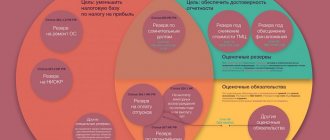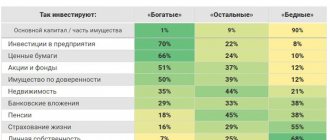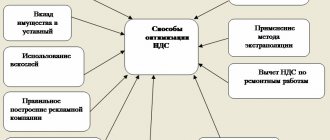In attempts to optimize taxation, companies sometimes resort to dubious schemes that are well known to the Federal Tax Service. As a result, the taxpayer receives not only additional tax assessments, but also penalties. However, there are legal ways to reduce mandatory payments. Let's figure out how to reduce income tax within the law and use these funds to benefit your business.
Legal approach
The legislation offers a whole range of tools for tax optimization - special regimes, benefits, zero rates and targeted preferences. For example, small and medium-sized businesses can switch to a simplified system. This will allow them not to pay VAT and pay tax on their income at reduced rates. However, large organizations and many medium-sized businesses cannot apply preferential treatment. They are faced with the question of how to reduce income tax under OSNO.
Tax is imposed on the difference between income received and expenses incurred in the course of business. The Tax Code strictly stipulates what constitutes income and expenses for the purposes of calculating income tax. Any amateur activity is unacceptable here - this is a direct violation of the law.
It is impossible to talk about ways to reduce income taxes without touching on the topic of gray and black optimization. The most obvious illegal practice is to attribute expenses that did not occur or to inflate the amount of expenses incurred. The Tax Service is actively and very successfully combating such violations. Therefore, in no case should you resort to this “optimization” scheme, as well as other illegal methods. Next, we will consider only legal methods.
Free tax consultation
Reduction of income tax under OSNO
The greatest scope for imagination opens up for taxpayers in the general regime.
Firstly, they can use all methods to reduce the tax of “simplified” people by 15%. And they can add a lot for themselves. Read below about the variety of options, from the simplest to the most sophisticated.
Creating reserves for future expenses
A provision is a write-off in the current period of expenses that will definitely be incurred in a future period.
In accordance with the law, a company can create reserves for the impairment of overdue accounts receivable, for the payment of vacation pay to employees, for annual bonus payments to employees (only specified in the employment contract), and for the depreciation of securities. You need to understand that creating a reserve helps speed up the recognition of expenses, and does not increase expenses as a whole. And if there is no expense in the future, the reserve will need to be restored (read: included in income).
Overestimation of associated costs
Almost every company rents an office or warehouse. In rented areas, it is necessary to maintain life systems, clean, and maintain fixed assets and other labor tools in good condition. All of these expenses are suitable tools for inflating costs.
Personnel training, consulting services
All these items relate to other costs associated with the production of goods. Therefore, train your staff. And you will receive benefits in the form of added value to the business, and the favor of employees, and you will reduce taxes.
The use of any type of consultation from software implementation to marketing research also reduces taxes.
Depreciation of fixed assets
Everyone knows that depreciation of fixed assets is taken into account as an expense when forming the tax base. But not everyone knows that when writing off a fixed asset, you can include in expenses all non-accrued depreciation, as well as the costs of dismantling, recycling and removal of the fixed asset
Offset of overpayments on taxes
Well, let us remind you that advances on income tax may not correspond to the final estimated tax amount for the period. Therefore, the organization accumulates overpayments that need to be read out on time. Otherwise, after three years you will lose these amounts irrevocably.
Creation of a group of companies, some of which are “simplified”
Further - more interesting. You can create a group of companies, some of which will use preferential tax regimes. And show most of the profit in them.
Scheme of actions of the group of companies
The main thing here is either not to advertise the connection between the founders of the group companies, or to make the group model justified. For example, you can segment your business by areas of activity, or by regions of presence. But if the tax inspector discovers the connection and finds it suspicious, you will need to provide a clear argument as to why you did what you did.
Use of offshore companies
The scheme for using offshore companies is similar to the previous one and is absolutely legal, despite the created image of “dark dealings”. Here, as in the previous version, the main thing is to prove to the tax inspector the validity of the existence of a group of companies.
Traditionally, the argument in favor of creating an offshore company is the presence of an intangible asset (copyrights, patents, brand) that needs to be protected. The asset is transferred to an offshore company, and companies in Russia pay for the use of royalties (read: withdraw funds to a low-tax jurisdiction).
Attention! All payment transactions abroad are controlled by the bank's currency control. For carrying out currency transactions using forged documents, Art. 193.1 of the Criminal Code of the Russian Federation provides for criminal liability. Therefore, make sure that payment documents are not deliberately false.
Transfer of assets to a simplified person
Transfer of assets is also an option for creating a group of companies, only now the company’s assets – machines, equipment, offices and other means of labor – become the main protagonist.
Asset action plan
The advantages of this scheme include not only savings on profit tax in a company on OSNO due to inflated expenses, but also the absence of property tax in a company using the simplified tax system. Everyone enjoys the scheme.
Profit tax savings due to leasing
Leasing is truly a treasure trove of tax optimization methods. You can choose one of the proposed options or use both:
- Accelerated depreciation of the leased asset. You can enter into an agreement with the lessor in such a form that, according to all accounting rules, you will have to assign a useful life equal to the term of the agreement. And that's what you need. The useful life is reduced - depreciation increases - income tax is reduced. At the same time, you reduce property tax, since it is proportional to the cost of fixed assets.
- Leaseback as a means of saving on taxes. The essence of leaseback: a company transfers its property to a leasing company, and then receives it on lease, i.e. actually takes out a loan secured by equipment. Thus, the company solves several financial problems, one of which is to reduce income tax by inflating expenses, the second is to reduce property tax due to the lack of property (on paper).
Write-off of losses from previous years
Not every year a company closes with a profit; losses also occur. The legislation allows them to be written off later. When submitting income tax reports, the current period declaration indicates the loss of previous years or part of it. In 2019-2020, the tax base can be reduced in a similar way by up to half. If the loss is greater, it can be carried forward to future years. Previously, there was a restriction that allowed losses to be carried forward in this way for 10 years, but now it has been removed.
It happens that losses from previous years are revealed only in the current year. They can be attributed to non-operating expenses, thereby reducing the tax base, and therefore the tax itself.
Creation of reserves
An organization may provide in its accounting policies for the creation of the following reserves:
- for doubtful debts;
- for vacation pay;
- for repairs of fixed assets;
- for warranty repairs and maintenance.
This can be very beneficial for optimizing income taxes. Let us explain using the example of the reserve for doubtful debts. The company shipped the goods to customers but did not receive payment. When accounting for income and expenses using the accrual method, she generated income on the date of shipment. And since there is income, it is also subject to income tax. It turns out that there is no money, but 20% of the theoretical amount of income needs to be paid.
To avoid this, a reserve for doubtful debts is created. At the end of the quarter, you need to determine the duration of the delay. If it is more than 45 days, then half of the debt amount is taken into account. If you are overdue for more than 90 days, you can write off the entire amount.
Of course, when counterparties repay their debts, tax will have to be paid. That is, the creation of a reserve can be used to legally obtain a tax deferment. You will need to pay taxes from what you receive, not from your own funds. The advantage of this method is that during the deferment the company’s money remains in operation and generates income.
Acquisition and liquidation of fixed assets
If you plan to purchase transport, equipment or other similar objects, you can consider leasing. The necessary equipment will be provided by the lessor, and the company will make payments to him. Until the end of payments, the equipment will be owned by the lessor, and the organization will be able to use it in its activities.
Optimization of income tax is as follows: leasing payments are included in the cost of production and reduce the base. If you buy equipment at your own expense, then only the depreciation amount can be taken into account as expenses.
Often new equipment is purchased to replace old equipment that is subject to write-off. The costs associated with its liquidation - dismantling, dismantling, removal - can be written off as non-operating expenses in the period when the liquidation occurs. These costs also include underaccrued depreciation of written-off objects.
Design and survey work
Hello, we have a question regarding tax accounting for expenses for design and survey work. The organization carried out the above-mentioned work related to the overhaul and reconstruction of the facility. Are there differences in the rules for attributing costs to design and survey work performed for these activities?
Of course, the rules for accounting for expenses for major repairs and reconstruction are different. Thus, costs for any type of repair are current and are recognized in the period in which they were carried out, in the amount of actual costs (clause 1 of Article 260 of the Tax Code of the Russian Federation). In addition, to ensure uniform write-off of costs, the taxpayer has the right to create a reserve for upcoming repair costs (clause 3 of Article 260 of the Tax Code of the Russian Federation).
Reconstruction costs are capital investments, that is, they increase the cost of fixed assets and are written off through depreciation (clause 2 of Article 257 and Article 258 of the Tax Code of the Russian Federation). In this situation, design and survey work is divided according to the purposes of its implementation. This means that the costs of performing these works are part of other costs: reconstruction and major repairs.
What to do if design and survey work for repairs has been completed, but the major repair itself has not begun? Is it possible to take into account the costs of performing these works at a time for profit tax purposes?
Yes, and in this case the costs of design and survey work can be taken into account at a time. After all, these costs relate to repair costs, which, as already mentioned, are recognized in the period of their implementation. Let me note that the above does not apply to the situation when an organization creates a reserve for repair costs.
Trademark registration
Many organizations today spend money on a trademark. This is another good example of how you can reduce profits absolutely legally, not only by reducing taxes, but also getting benefits for business. After all, a trademark contributes to the recognition of the company, the formation of customer loyalty and protection from unfair competition.
After receiving documents from Rospatent, the trademark is registered as an intangible asset. The costs for it, provided that they amounted to less than 100,000 rubles, are immediately included in expenses and reduce the income tax base. If a trademark is more expensive, it is subject to depreciation, and its cost is reduced by tax gradually.
Reduction of single tax with simplified tax system 15%
Those who have chosen the simplified tax system “income-expenses” have a much wider field for creativity in reducing taxes.
Accordingly, within the limits of allowed expenses, you can reduce the tax base. Let's see how this can be done.
It should be taken into account that income cannot be reduced by all expenses. Article 346.16 of the Tax Code of the Russian Federation describes in detail what expenses can be recognized.
Accounting for the minimum tax for the previous period
If last year you paid the minimum tax, then this year you can offset the amount by which the minimum tax exceeded the calculated single tax.
Accounting for past losses
If in one or more previous years you incurred a loss, you can offset the amount of the loss when calculating your tax base. You can use data for the past 10 years.
Increasing expenses within the limits allowed
Here are some extremely legal ways to increase your company's expenses without spending anything:
- Employment of company owners. Everything is simple here: by working in your own business, you increase the company’s expenses on your wages. If you only received dividends, you would not be able to reduce your tax base on them. The direct benefit, of course, will be small, since you will pay personal income tax in the amount of 13% of your salary and also social contributions. But how many opportunities will open up for you! You will be able to go on business trips for work, study, buy consumables and fixed assets to perform your duties. And all this will be included in the expenses of your business.
- Inclusion of the owner's property in fixed assets. For example, you work as a general director. And you buy yourself a new car so that you can drive it to work. Register your car as a fixed asset and you will reduce your monthly expenses by the amount of depreciation, fuel, maintenance and washing services.
- The acquisition by an organization of property actually necessary for the business owner. Let's say you earned a good profit, and you have a decent amount of money and an equally decent tax base. You can buy commercial space for your organization and rent it out to yourself for a nominal fee. You will then sublease it yourself. The “one pocket” principle works here. That is, you simply transfer money from one pocket to another, while reducing taxes.
- Bypassing regulated expenses. Some of the expenses listed in Article 346.16 of the Tax Code of the Russian Federation are regulated. That is, they cannot be more than a certain amount. These include: expenses for workwear and uniforms, entertainment expenses, interest on loans in excess of the norm, and others. These costs affect almost all types of businesses, so bypassing regulations has a strong positive effect.
A good example of circumventing the rules would be the replacement of compensation for the use of personal vehicles for business purposes with rental agreements for employees’ personal cars in taxi companies. It seems to be the same, but the tax base is smaller.
If, based on the results of calculations, the tax amount is less than 1% of the amount of income, 1% of the amount of income must be paid to the budget.
Video - White ways to optimize taxes
Uniform
Continuing the conversation about the trademark, it is worth mentioning another attribute of the corporate identity of the organization - the uniform of the employees. This is especially true in the field of retail trade and services to the public.
The costs of manufacturing the form are included in labor costs on the basis of paragraph 5 of Article 255 of the Tax Code of the Russian Federation. And they, in turn, lower the tax base. However, for this, 2 conditions must be met:
- uniforms are provided to employees free of charge or at a reduced price;
- the employee receives it as property, that is, after termination of the employment contract there is no need to return it.
Marketing research
Often companies resort to the services of marketers to study the market in order to increase their sales. If such studies have not yet been conducted, it probably makes sense to think about it. Moreover, the costs for them reduce the income tax base as consultation costs.
However, this is true under one condition - such costs are justified, documented and made in order to increase income. Market research should be conducted on the products or services that the company is engaged in. If it is directed to some third-party products, then the expenses may not be recognized. The Federal Tax Service will decide that the study was fictitious and was carried out solely to reduce income tax.
Founder's financial assistance
Alexandra Sergeevna! Tell me, is any gratuitous financial assistance provided by a participant, regardless of his share in the company, not subject to income tax in 2011? Is the limitation on the size of the share (more than 50%) for an individual, which is established in paragraph 4 of subclause 11 of clause 1 of Article 251 of the Tax Code of the Russian Federation, canceled since 2011 due to the entry into force of subclause 3.4 of clause 1 of Article 251 of the Tax Code of the Russian Federation on December 31, 2010 ?
These rules provide for different grounds for non-payment of income tax, so it is incorrect to talk about abolishing the restriction on the participant’s share being more than 50%.
In connection with the entry into force of subclause 3.4 of clause 1 of Article 251 of the Tax Code of the Russian Federation, organizations receiving gratuitous assistance from a company participant with a share of less than 50% have a basis for non-payment of income tax on such funds. But for an organization to apply these provisions, it is necessary that the participant transfer property in order to increase its net assets.
To prove this, an appropriate decision must be made and the necessary documents drawn up. At the same time, let me remind you that the effect of this subparagraph applies to legal relations that arose from January 1, 2007.
The norms of subparagraph 11 of paragraph 1 of Article 251 of the Tax Code of the Russian Federation are still in effect, since not every transfer of funds is made with the aim of increasing net assets and is properly formalized. In this case, there is a restriction regarding the participant’s share, which must be more than 50%.
If a participant with a share of more than 50% provides gratuitous financial assistance in order to increase the net assets of the organization, then such an organization has both considered grounds for non-payment of income tax.
Employee training
If the organization’s specialists periodically improve their professional level, this will only benefit the business. In addition, training expenses can reduce income taxes - they are written off as other production and sales expenses.
To do this, the following conditions must be met:
- employees sent for training are hired under employment contracts;
- The educational institution with which the agreement is concluded has the right to conduct relevant activities.
Reduction of single tax with simplified tax system 6%
You can reduce the income tax of 6% under the simplified tax system in the same way as UTII by subtracting from the resulting tax amount:
- Contributions to the Pension Fund, Compulsory Medical Insurance Fund, Social Insurance Fund.
- Payment of sick leave.
- Payments for voluntary health insurance for employees.
If you are an individual entrepreneur in the singular, then you can apply deductions in the full amount, but if you use hired labor, then you can reduce the single tax by only 50%.
Table 1.
Tax reduction rules
| Rule 1 | You can reduce your tax only in the period in which you paid your contributions. |
| Rule 2 | You can reduce tax only for those periods when you calculated contributions as a “simplified” tax. |
| Rule 3 | You cannot reduce your tax on the amount of overpayments on social contributions. |
| Rule 4 | If you are repaying debts to extra-budgetary funds for previous periods, then you can deduct the amount of payments. |
Preferential rates
The income tax rate of 20% consists of two parts. In 2020 they are:
- regional - 17%;
- federal - 3%.
For certain categories of taxpayers, federal and regional rates are set at zero. That is, such companies do not actually pay this tax. A 0% rate applies to income received:
- educational and medical organizations;
- organizations providing social services to citizens;
- participants of the Skolkovo project;
- agricultural producers and fisheries organizations.
In addition, the federal portion of income tax is zero for residents:
- free economic zone of Crimea and Sevastopol;
- port of Vladivostok;
- economic zone of the Magadan and Kaliningrad regions;
- tourist and recreational cluster and some other zones.
The regional part of the rate may be lowered by decisions of the authorities of a constituent entity of the Russian Federation for certain categories of payers. Thus, in Moscow for public organizations of disabled people, as well as those who use their labor, the regional rate is set at 12.5%.
When checking an income tax return, the Federal Tax Service may request documents necessary to confirm rights to preferential rates.
Investment deduction
From January 1, 2020, an investment deduction is in effect, which reduces the amount of income tax (not the tax base). The mechanism for its application is prescribed in Article 286.1 of the Tax Code of the Russian Federation. The conditions are:
- In the entity where the taxpayer is located, a law on investment deduction must be adopted.
- The organization must establish in its accounting policies that it has the right to apply this deduction. For this right to appear in 2020, it must be recorded in the accounting policy before
- the end of this year. In the future, this decision cannot be changed for 3 years.
- The deduction applies to facilities that have been put into operation since the beginning of 2020. Or after this date their cost was revised.
- The deduction applies to all objects that belong to depreciation groups III-VII.
- The regional part of the income tax can be reduced by up to 90% of the costs incurred by the taxpayer in connection with the acquisition, modernization or reconstruction of fixed assets. Moreover, this part of the tax must be at least 5% of the tax base.
- The federal portion of the tax can be reduced by no more than 10% of the amount of costs. There is no minimum tax established.
So, we looked at how to reduce income tax under OSNO within the framework of the law. Most legal methods come down to properly accounting for expenses. Companies should periodically review their costs. It is likely that funds will eventually be freed up, which can be used to develop the business.
Check the table to see which taxes have been reduced in your region
Regional authorities are reducing rates for the simplified tax system, reducing the potential income from a patent, and introducing reduced coefficients for UTII. Additional measures: rental holidays, preferential loans, abolition of transport tax for organizations and others - depending on the subject of the Federation.
In most regions, reduced rates will remain in effect throughout 2020. This means that the tax can be recalculated from January 1, but there may be exceptions.
Basically, benefits are given to victims based on the main type of activity according to the Unified State Register of Individual Entrepreneurs / Unified State Register of Legal Entities. Some regions prescribe OKVEDs in the text of the law, others are guided by the Decree of the Government of the Russian Federation No. 434.
In the Primorsky Territory and the Tyumen Region, rates under the simplified tax system “Income” were reduced for everyone.
In the Republic of Tyva, the simplified tax system “Income” is now 1%, “Income minus expenses” is 5%, and the potential income for all types of activities on a patent is 16.67 rubles. But these regions are the exception rather than the rule.
Before recalculating taxes, check all the conditions in the law in your region. Or call the tax office.
Quick search in the table - keyboard shortcut Ctrl+F.
| Region | Law | simplified tax system | Patent |
| Republic of Adygea | Law of the Republic of Adygea dated April 27, 2020 No. 339 | For victims, “Income” - 1%, “Income minus expenses” - 5%. It is necessary to retain at least 90% of the staff according to the average number relative to March 1, 2020. The list of affected OKVEDs is in the appendix to the local law. At least 70% of income must come from these types of activities | For individual entrepreneurs registered for the first time after April 29, 2020, the rate is 0%. The list of activities is in the appendix to the local law. |
| Altai Republic | Law of the Altai Republic dated June 11, 2020 No. 29-RZ |







